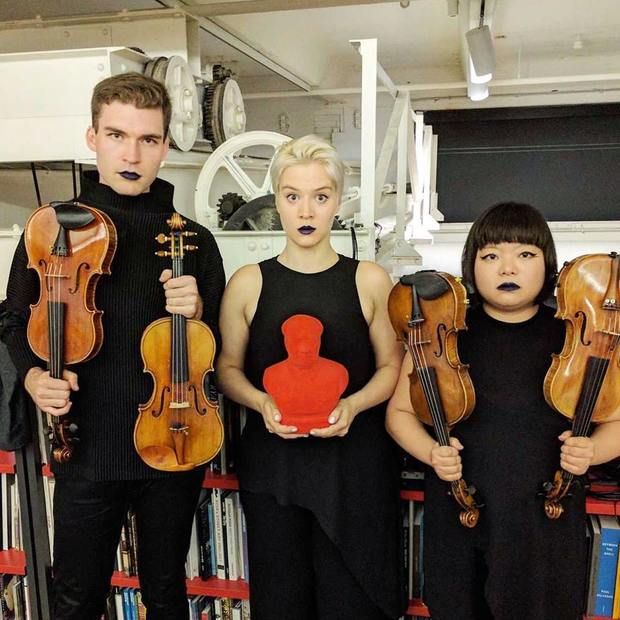Review: ChamberFest Cleveland
21/06/17
ChamberFest Cleveland performance of 'Kafka Fragments' coalesces into riveting whole (review)

Violinists Alexi Kenney, left, and Yura Lee, right, pose with soprano Lauren Eberwein at their performance of Kurtag's "Kafka Fragments" at ChamberFest Cleveland Tuesday evening. (Courtesy of ChamberFest Cleveland)
By Zachary Lewis, The Plain Dealer zlewis@plaind.com
CLEVELAND, Ohio - Nothing partial or incomplete about the presentation of Kurtag's "Kafka Fragments" Tuesday night at ChamberFest Cleveland.
The score, the performances, the interpretive film by Cleveland Arts Prize winner Kasumi. All elements aligned in support of a remarkable evening.
Even the weather cooperated. During a fragment called "Everything Flows," while the film showed raindrops and lapping waves, there came a torrential, pounding, and perfectly apt downpour that nearly drowned out the music.
The divine display was unnecessary, as it happens. Long before it began to rain, the musicians and filmmaker had a full house at the Transformer Station squarely in the palm of their hands.
Start with the score itself, a collection of 40 (sometimes very) short pieces for soprano and violin, completed in 1987. Simply put: a better realization of Kafka in music is hard to imagine. The texts are disconnected, enigmatic, and sometimes brazenly bizarre, and Kurtag's carefully crafted miniatures distill their essence exactly.
About the performances, it would be impossible to say too much.
Mezzo-soprano Lauren Eberwein was flat-out stunning; She handled a part every bit as difficult as an atonal opera with beautiful aplomb, knocking out one huge leap after another with nary a moment's insecurity or the slightest lapse in expressive control.
Ditto violinists Alexi Kenney and Yura Lee. Proving that two heads are better than one, especially in music, the ChamberFest regulars tore through a daunting part conceived for one musician with unflagging ferocity and a brilliant palette of emotional colors.
On their own, these three would have been plenty compelling. But with Kasumi's original film sequences in the mix as well, the presentation commanded attention every second of its roughly 70-minute duration.
It's hard to guess at the approaches other artists might have taken. All one can say is that Kasumi's worked.
She took the aphorisms at their word. For most of the actions, objects, and moods described by Kafka, Kasumi found or shot literal depictions, employing a dazzling array of transition effects and filtering almost everything through the black-and-white prism of film noir and early horror. Clocks, gears, landscapes, facial close-ups, and machinery were prominent motifs.
Color appeared only now and then, mostly as respite or for sheer shock value. The result was a direct reflection of both the music and the text, in all their bleak, paranoid glory.
By way of introduction Tuesday, ChamberFest Cleveland co-founder Franklin Cohen described the Kurtag program as a "bold experiment."
He may now consider that experiment a success. This year's edition of ChamberFest still has a lot of ground to cover, but the territory it just crossed won't soon be forgotten.

Violinists Alexi Kenney, left, and Yura Lee, right, pose with soprano Lauren Eberwein at their performance of Kurtag's "Kafka Fragments" at ChamberFest Cleveland Tuesday evening. (Courtesy of ChamberFest Cleveland)
By Zachary Lewis, The Plain Dealer zlewis@plaind.com
CLEVELAND, Ohio - Nothing partial or incomplete about the presentation of Kurtag's "Kafka Fragments" Tuesday night at ChamberFest Cleveland.
The score, the performances, the interpretive film by Cleveland Arts Prize winner Kasumi. All elements aligned in support of a remarkable evening.
Even the weather cooperated. During a fragment called "Everything Flows," while the film showed raindrops and lapping waves, there came a torrential, pounding, and perfectly apt downpour that nearly drowned out the music.
The divine display was unnecessary, as it happens. Long before it began to rain, the musicians and filmmaker had a full house at the Transformer Station squarely in the palm of their hands.
Start with the score itself, a collection of 40 (sometimes very) short pieces for soprano and violin, completed in 1987. Simply put: a better realization of Kafka in music is hard to imagine. The texts are disconnected, enigmatic, and sometimes brazenly bizarre, and Kurtag's carefully crafted miniatures distill their essence exactly.
About the performances, it would be impossible to say too much.
Mezzo-soprano Lauren Eberwein was flat-out stunning; She handled a part every bit as difficult as an atonal opera with beautiful aplomb, knocking out one huge leap after another with nary a moment's insecurity or the slightest lapse in expressive control.
Ditto violinists Alexi Kenney and Yura Lee. Proving that two heads are better than one, especially in music, the ChamberFest regulars tore through a daunting part conceived for one musician with unflagging ferocity and a brilliant palette of emotional colors.
On their own, these three would have been plenty compelling. But with Kasumi's original film sequences in the mix as well, the presentation commanded attention every second of its roughly 70-minute duration.
It's hard to guess at the approaches other artists might have taken. All one can say is that Kasumi's worked.
She took the aphorisms at their word. For most of the actions, objects, and moods described by Kafka, Kasumi found or shot literal depictions, employing a dazzling array of transition effects and filtering almost everything through the black-and-white prism of film noir and early horror. Clocks, gears, landscapes, facial close-ups, and machinery were prominent motifs.
Color appeared only now and then, mostly as respite or for sheer shock value. The result was a direct reflection of both the music and the text, in all their bleak, paranoid glory.
By way of introduction Tuesday, ChamberFest Cleveland co-founder Franklin Cohen described the Kurtag program as a "bold experiment."
He may now consider that experiment a success. This year's edition of ChamberFest still has a lot of ground to cover, but the territory it just crossed won't soon be forgotten.


